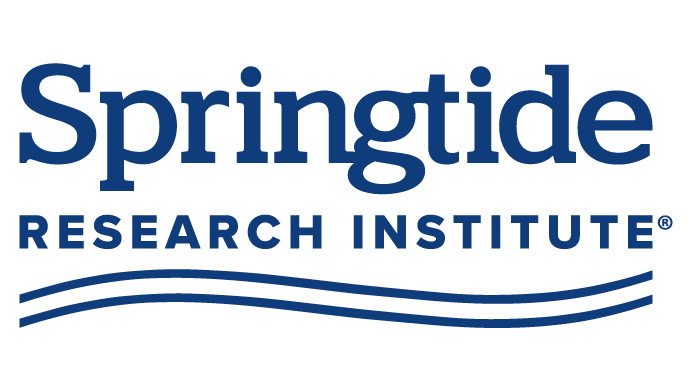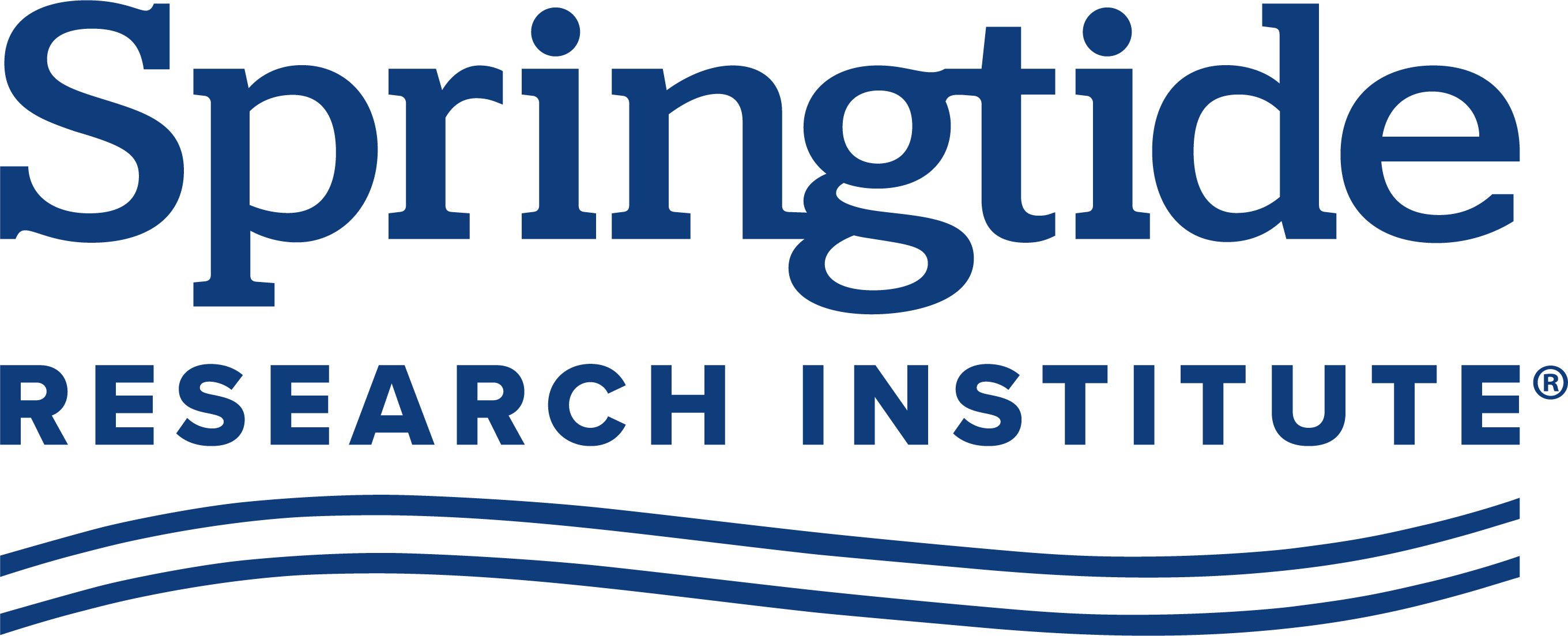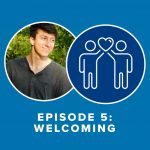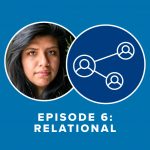Meet the Cofounders of Teens Helping Seniors
When social distancing measures went into effect in spring 2020, vulnerable populations, like senior citizens, were deemed high-risk for experiencing life-threatening symptoms related to COVID-19. There was increased uncertainty regarding how elderly and immunocompromised populations might safely navigate grocery stores for obtaining food, medications, and necessary supplies.
Two young people in Silver Spring, Maryland—Dhruv Pai, age 16, and Matthew Casertano, age 15, both in their sophomore year at Montgomery Blair High School—recognized this need and began assisting senior adults in their extended families and neighborhoods with grocery deliveries.
Out of this initial response they shared in their own community, Dhruv and Matthew inspired and built a larger movement: Teens Helping Seniors. This volunteer organization connects seniors and those who are immunocompromised with teens and young adults who can offer support by shopping for and delivering various necessities during the COVID-19 pandemic and beyond. They don’t charge a service fee, and all deliveries are completed through contactless methods. As of writing, Teens Helping Seniors has grown to include twenty-seven chapters in sixteen different states (as well as Montreal, Canada), is powered by more than 630 volunteers, and has made more than 1,500 grocery deliveries.
In the interview below, Springtide™ Research Institute invited Dhruv and Matthew to tell us about their experiences building this volunteer organization, what motivates them to do good, how they’re staying connected amid social distancing, and more.
Our Q&A with Dhruv & Matthew:
What inspired you to create and launch this initiative?
Dhruv: I was helping my grandparents as well as elderly neighbors by delivering groceries to their doorsteps when COVID cases were first announced in Maryland. While carpooling to school, Matthew mentioned that he was buying groceries for his grandparents too. That is when I realized the greater need to deliver groceries to those who cannot get out of the house during the pandemic and decided to start a volunteer effort by getting more friends together. We discussed how other vulnerable and immunocompromised elderly citizens would need help during the crisis and started this volunteer organization calling it Teens Helping Seniors.
Matthew: Yes—Dhruv mentioned to me that he had to pick up some groceries and a prescription for his grandparents after school that day, and I told him that I had been doing the same the past few weeks. At that point, we sort of thought for a minute, and Dhruv posed the question, “What are people without grandchildren, without relatives, or without friends or neighbors who could do their shopping for them going to do? Are they going to have to go out on their own to get groceries and risk their health?” That question was the springboard for our organization. We had a two-week break from school ahead of us (which was extended as the virus worsened), and both of us realized we could connect teens, who would have a lot of free time, with seniors who would be in desperate need of assistance.
How have you seen Teens Helping Seniors expand from your initial project?
When we first started Teens Helping Seniors, we were expecting it to be a small, local project that would help out a few members of our community. About a week into the project, we got our first press request from a small county media outlet. We figured this would give us a good opportunity to reach seniors and volunteers around our county. However, when the article was published, we got requests and inquiries from people in neighboring counties and even neighboring states, which we later found out was the result of hundreds of social media shares. This made us realize that Teens Helping Seniors had the potential to be something much bigger than we had anticipated, and we both felt obligated to expand it as a result. That day, we opened our first non-flagship chapter in Howard County, Maryland. One week later, as a result of continued growth and interest from people across the country, we opened a chapter in New York and officially became national. One week after that, we opened a chapter in Canada and officially became an international volunteer organization.
This growth has certainly been unexpected and at times overwhelming for us, but we are thrilled it has occurred, because of the sheer volume of seniors we have been able to help. Our largest single chapter is the flagship one in Montgomery County, Maryland, which has made approximately 700 deliveries. Our second largest is in Montreal, Canada, which has made over 200 deliveries.
Have you seen the scope or mission of Teens Helping Seniors evolve from your original vision?
There have been three main changes to the scope and mission of Teens Helping Seniors. The first is we expanded our target demographic to also include dementia patients and disabled veterans. This change is the result of partnerships with organizations like the Alzheimer’s Foundation of America and Serving Together. The second change is that we have sought to get important information out to seniors about early signs of dementia, elder abuse, and fire safety. This is the result of partnerships with the aforementioned organizations as well as the Charles E. Smith Life Communities ElderSAFE Center and the Montgomery County Senior Citizen Fire Safety Task Force. The third change is that we have placed a greater focus on the mental health aspect of our service. Many seniors have been stuck at home, unable to see family or friends, for several months now, and the negative psychological effects of such long isolation are very well documented. To counter this, we have taken steps such as creating a call team to ask seniors how they’re doing after deliveries and implementing a system where volunteers leave a small, heartfelt note to seniors along with the necessities they requested.
Some of our chapters are also offering unique services such as delivering essential supplies to seniors within a local nursing home in Phoenix, AZ. These seniors live in their own apartments within the campus of the nursing home. The volunteers are also including cards of gratitude and hope with the groceries they deliver. Our chapter in Montreal, Canada, is delivering food to those in need from local food banks in addition to providing contactless grocery deliveries.
How has creating and participating in Teens Helping Seniors impacted or shaped you?
Dhruv: By creating Teens Helping Seniors, I realized that teenagers have the power to make a difference. My world changed when I began volunteering. What started in early middle school as something I had to do to get service hours has now become something I am passionate about and plan to continue for the remainder of my life. I will continue to work through Teens Helping Seniors as well as other organizations serving the local community.
Matthew: I think that creating and participating in Teens Helping Seniors has made me into a more compassionate person who truly sees the value of altruism. I’ve realized how beautiful it is for someone to help a person they don’t know.
What has it been like to see this idea grow and take off?
Dhruv: It has been amazing to see what started as a small group effort to help our neighbors grow into an international effort. Thanks to our teen volunteers, we are proud of how we came together during the crisis to keep our communities safe.
Matthew: Teens Helping Seniors has become something much bigger than we ever expected. With 1,500 deliveries completed, we have kept a senior away from a potentially deadly virus 1,500 times. I don’t think it’s a stretch to say it’s possible that this shared project has saved lives. Recognizing this has given me a greater sense of purpose and meaning to counter any feelings of loneliness, depression, and despair I have developed as a result of being unable to see family and friends. I’ve been able to stay motivated as I wake up each day to emails from people of all generations around the world saying how appreciative they are of this service, how needed it is, and how this gives them hope in the younger generation. Many of these emails come from people who simply saw us in the media or helping seniors in their communities. It’s an amazing feeling to be able to see this every morning and know how much of an impact our work is making.
If someone had never met either of you before, what would be some important identities you’d want them to know about each of you?
Dhruv: I have a passion for research work in STEM (science, technology, engineering, and math) as well as volunteering. I would like to combine technology and innovation along with empathy towards people to bring about a positive change in the society. For example, while volunteering, I noticed that some seniors with dementia had the tendency to wander off and get lost, which would cause undue stress on their family. In order to help patients with dementia, I have developed a low-cost technology tracking ring called K-ring. The K-ring is a ring which is worn on the finger of the patient that allows the wanderer to be tracked using a QR code and a passive NFC code. In addition, I am an avid singer, composing my own music, have been playing the guitar for the past 10 years, and am now learning the violin. I am also a major cat person and have two cats of my own: KitKat & Snickers.
Matthew: I like to think of myself as a kind and thoughtful person who enjoys being with my friends, bonding with my family, and helping others when I’m able to. I also would say that I’m curious, adventurous, and always trying to learn and experience new things. My favorite subjects are math and computer science, and I closely follow politics and the stock market.
Where do you find meaning and/or purpose in life?
Dhruv: I find purpose in alleviating other people’s pain and suffering. When I was in elementary school, I noticed that my classmate was being bullied every single day by other boys in the school. I comforted him as well as I could, stayed with him during lunch each day, and vowed I would do something to keep this from happening to others. When I was in middle school, another classmate who was new to the school was being bullied because he was a strong introvert. I supported him, and to this day, these two are some of my closest friends, even though we are now in different schools. Developing empathy by standing up to bullying and comforting one another through hard times has given me a sense of purpose and improved my leadership skills as well as my own well-being. Similarly, volunteering gives me a sense of fulfillment because I feel like I am contributing to something larger than myself.
Matthew: I find meaning and purpose in helping others in my community and making a difference in the world. I am a very social person, so this pandemic would have been hard for me if it were not for Teens Helping Seniors, which has given me the opportunity to interact with people daily.
Would either of you describe yourself as having a spiritual/faith/religious identity? If so, how does that identity influence how you find meaning and purpose?
Dhruv: Though I am raised in a relatively traditional household, I would describe myself as not having a spiritual identity. I think that if we believed in each other half as much as we believed in God, the world would be a better place to live in. I also consider myself to be bi-cultural: born and raised in the US by parents who came from India. Being bi-cultural has made me more flexible and creative in my thinking. Through volunteering and serving different communities, I have been able to explore my sense of self, how that relates to the identities I hold at home, and how this stems from identities in my immediate community. Teens Helping Seniors has allowed me to build a platform for expanding my perspectives and exploring how I can adapt into contexts beyond those I have experienced before.
Matthew: I am Jewish and would say that this identity has a definite influence on how I find meaning and purpose. Specifically, my Judaism teaches me the value of preserving human life, which we are taught overrides virtually all of our religious rules by the principle of pikuach nefesh. We can see this in the Mishnah (a book of Jewish exegetics), where it is asked why G-d decided to initially create the world with only one person (Adam). We then learn the answer, that G-d did so in order to demonstrate that even one person can make a complete world. From this, it is derived that “whoever saves one life saves the world entire,” a quotation that I personally interpret as demonstrating two important principles in Judaism: (1) that the value of life is practically infinite and (2) that every person is capable of making a big difference in the world. Both of these principles have motivated my work with Teens Helping Seniors, which I recognize has potentially been lifesaving.
Who are the people you’re safely connecting with during this ongoing season of social distancing?
Dhruv: I am connecting with friends through online platforms as well as in person while practicing social distancing and wearing masks. I have been playing video games, doing online competitions with friends, and participating in a virtual choir twice a week. Through Teens Helping Seniors, I’ve been able to make new connections with friends over our common interests to help our communities and our desire to have a real and lasting impact on the world.
Matthew: Since going into lockdown, I have limited myself to seeing only family members and necessary connections related to Teens Helping Seniors. When I see family outside my home, I have worn a mask, practiced social distancing guidelines, and remained outdoors. I have been especially careful when interacting with my grandfather, who was recently in long-term care for three months due to an infection, having just returned home in mid-January.
Are trusted adults checking in with you (inside or outside your home) during this time? What does that connection mean to you?
Dhruv: My parents are always there to support me at home. They make sure I have the necessary social interaction with a few of my friends by meeting them virtually or in-person. I have been doing additional outdoor activities with my friends such as hiking, going on long walks along the Potomac River, and playing non-contact games while practicing social distancing. Our school’s counselors, several teachers, and the principal have been in regular communication with us, which means a lot, and they have offered full support to our cause, which has motivated us to serve more in the community.
Matthew: My extended family has checked in with me frequently. In fact, I would say I have developed a closer relationship with much of my family despite not being able to see them. One project that I have done in my spare time over the last few months is trying to build a family tree. I have spent hours talking to my parents and grandparents in creating this, and I think it has been a great bonding experience. Additionally, staff members from my school, including several of my teachers, my counselor, and my principal, have checked in with me frequently and provided support to Teens Helping Seniors.
What has summer 2020 looked like for you through COVID-19?
Dhruv: I was accepted into a summer internship program in France this summer, which had to change to an online internship due to the pandemic. I was also accepted as a volunteer intern in the Walter Reed National Military Medical Center, which was also canceled. I had thoroughly enjoyed both of these experiences last year, which unfortunately did not pan out this year. However, I have been able to participate in more competitions and individual and group science projects since all activities are virtual and do not involve travel. When the pandemic started, due to my previous interactions with seniors and veterans with disabilities in hospitals, I saw a greater need in the community to help during the pandemic, which in turn shaped Teens Helping Seniors. I also had the honor to organize and coordinate delivery of stress relief kits to frontline workers in many hospitals and art activity kits to seniors in nursing homes (to help alleviate boredom) through my work with Arts-n-STEM4hearts. I’ve also been providing online tutoring services to my peers as part of my school’s math honor society.
Matthew: I was planning to see my friends often over the summer, but I haven’t been able to do that. The only exception is that I have seen Dhruv, but that has been exclusively for the purposes of Teens Helping Seniors, and we have had to social distance and wear a mask in all our interactions. My family was also planning to take a vacation this summer to somewhere in Europe, which would have been my first time leaving the continent, but we had to drop our plans in March. It definitely is a disappointment to miss out on time with friends and a vacation I was really looking forward to, but I recognize that the health of myself and those I interact with has to come first.
Do you have a sense of what your academic and social life will look like in fall 2020?
Dhruv: Our public school system will be starting the school year entirely online for the first semester and will reopen in phases for in-school learning. They are still working out the logistics of how this will work and what this will look like. We are being informed via regular emails.
Matthew: Our county recently announced that all instruction will be held virtually for the first semester of school. This means that we will be learning from home until at least late January, at which point we may continue online school, progress to normal full in-person instruction, or transition to some hybrid of the two. I expect that my social life will be similarly limited, and I will not be able to hang out with my friends. Even though the risk for teenagers like myself may be relatively low, I recognize that I am at best a vector for the virus who can easily spread it to friends, family members, and strangers. Thus, I feel a responsibility to stay safe to protect both myself and the people I interact with.
How can young people or adult volunteers get involved in Teens Helping Seniors?
Any volunteer interested in assisting our organization is asked to find their local chapter on our website (teenshelpingseniors.org) and follow the instructions provided there. If there is no chapter near them and they are interested in starting one, we ask that they send a message to our national email address (teenshelpingseniors@gmail.com). We will provide resources to get them started, their own space on our website, and meet with them once a week to discuss the progress of their chapter. They are also welcome to speak with any founders of our existing chapters before committing to starting their own, if they would like.
How can seniors or potential clients request assistance from Teens Helping Seniors?
If a senior is able to navigate our website (teenshelpingseniors.org), we ask that they find their local chapter there and follow the instructions provided. However, we recognize that this may be too complex for many seniors, so they may also simply send a message to our national email address (teenshelpingseniors@gmail.com) with their location, and we can manually provide the email of their closest chapter. If we do not yet have a chapter in the area of a senior and they would like to be notified if/when we open one, they may also contact our national email (teenshelpingseniors@gmail.com) with this request.
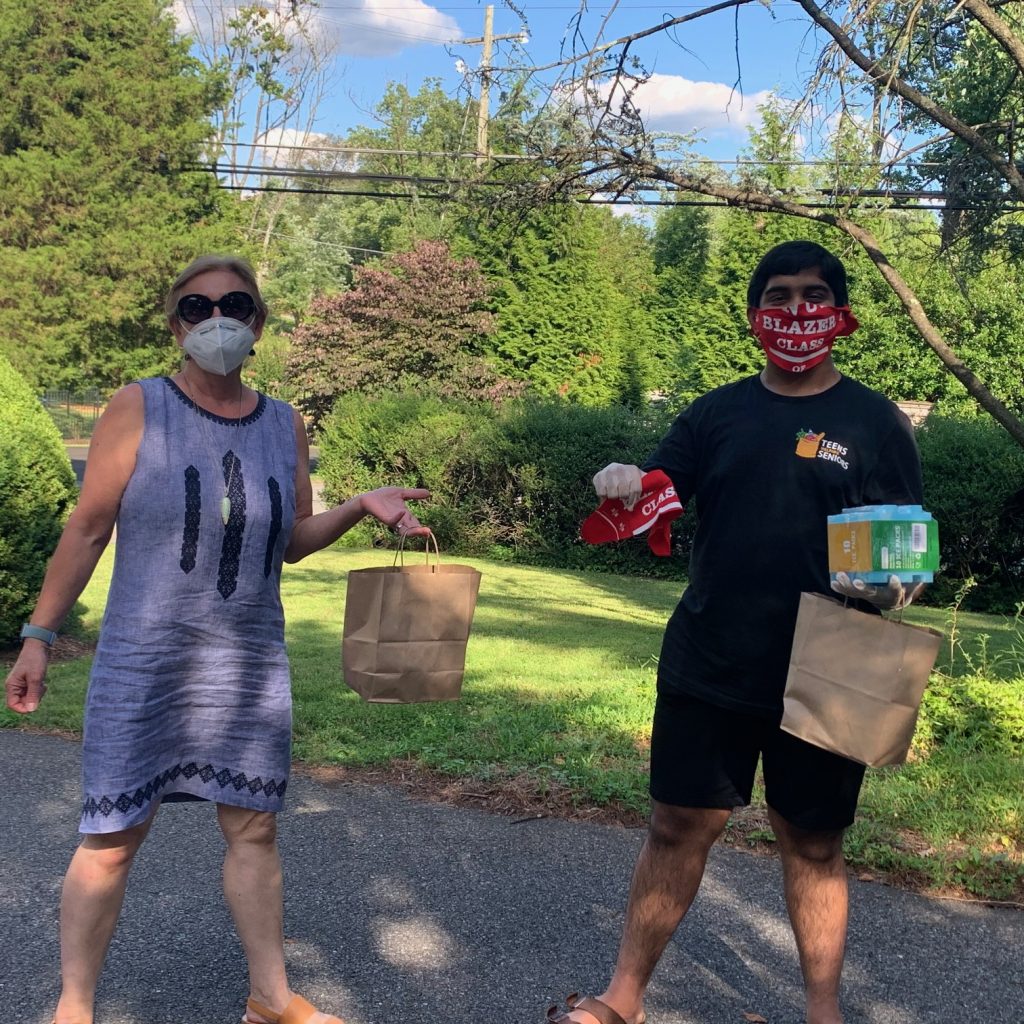
Images shared by Dhruv and Matthew from some of their Teens Helping Seniors shopping and delivery days in spring 2020 in Maryland.
____________________
Springtide released a Social Distance Study in April 2020, which found that the single most important way to mitigate young people’s experiences of loneliness is for trusted adults to reach out and connect with young people. While many young people, like Dhruv and Matthew, continue to find creative and community-building outlets even through the challenges of COVID-19, our research confirms the ongoing need for trusted adults to be relationship-driven with the youth and young adults in their communities. Consider how you might safely connect to the young people in your circle of care by engaging their interests or encouraging their creative or charitable pursuits.
